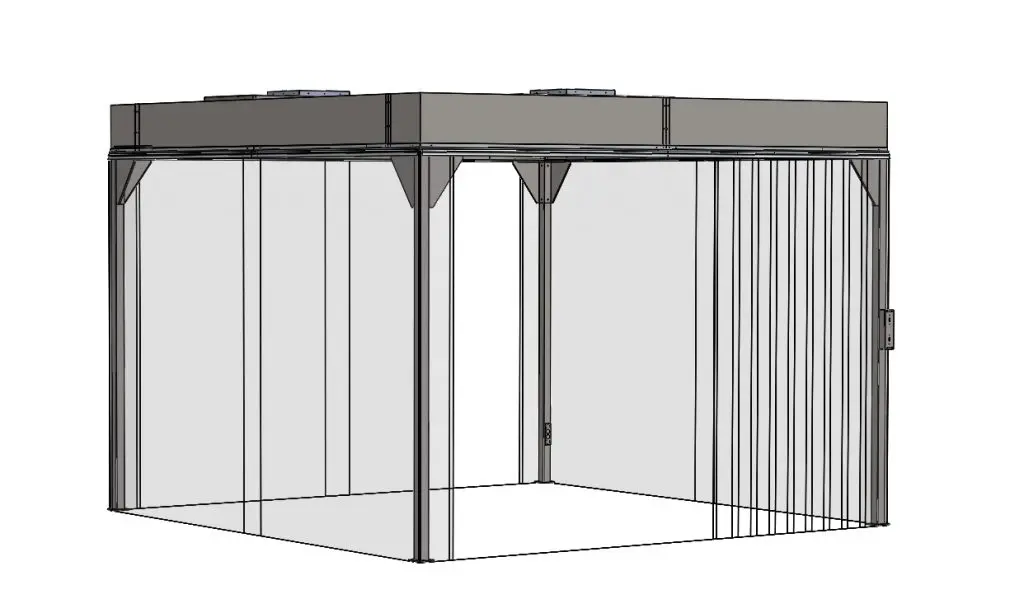Cleanrooms are essential environments in various industries, from pharmaceuticals and electronics to aerospace and biotechnology. They provide controlled conditions to prevent contamination and maintain product quality. Two common types of cleanrooms are softwall modular cleanrooms and hardwall cleanrooms.
Each has its unique features and maintenance requirements. In this guide provided by Ezad Cleanrooms, we will explore the specific maintenance and upkeep requirements unique to softwall modular cleanrooms and how they differ from hardwall cleanrooms. Understanding these differences is crucial for ensuring the longevity and performance of your cleanroom facility.
I. Softwall Modular Cleanrooms
Softwall modular cleanrooms are versatile, cost-effective, and customizable solutions for maintaining clean environments. They consist of lightweight materials such as flexible curtains or panels, making them easy to install and reconfigure. Maintenance for softwall modular cleanrooms requires attention to specific aspects:
Curtain and Panel Inspection: Regularly inspect the curtains or panels for wear, tears, or damage. Softwall cleanrooms depend on their barriers to maintain clean conditions, and any breaches can compromise their effectiveness. Replace damaged curtains promptly to prevent contamination.
Cleanliness and Contaminant Removal: Softwall cleanrooms are susceptible to dust and particulate accumulation on their surfaces. Establish a cleaning schedule to remove contaminants, using appropriate cleaning agents and methods that won't damage the curtain or panel materials.
Air Filtration System Maintenance: Softwall cleanrooms rely on efficient air filtration systems to maintain cleanliness. Ensure that the filters are cleaned or replaced according to the manufacturer's recommendations. Regularly monitor airflow and pressure differentials to confirm proper ventilation.
Seal Inspection: Pay close attention to the seals around the curtains or panels. Damaged or worn seals can allow unfiltered air to enter the cleanroom, compromising its integrity. Replace or repair seals as needed.
Static Control: Softwall cleanrooms often require specific measures for controlling static electricity. Implement antistatic flooring and equipment to prevent electrostatic discharge, which can damage sensitive equipment and products.
Ergonomic Design: Ensure that the layout and placement of equipment and workstations in the cleanroom consider ergonomic principles. This reduces the risk of operator fatigue and errors, which can lead to contamination incidents.
Regular Training: Train personnel in cleanroom protocols and procedures. Continuous education is vital for maintaining a contamination-free environment.
II. Hardwall Cleanrooms
Hardwall cleanrooms are more permanent structures, typically constructed with rigid walls and ceilings. They offer greater durability and security but come with their own set of maintenance and upkeep requirements:
Structural Integrity: Regularly inspect the structural components of hardwall cleanrooms, including walls, ceilings, and floors. Ensure that there are no cracks, leaks, or signs of deterioration that could compromise the cleanroom's integrity.
HVAC Systems: Maintain the heating, ventilation, and air conditioning (HVAC) systems meticulously. Hardwall cleanrooms rely on precise temperature and humidity control to meet strict environmental conditions. Replace filters, clean ducts, and calibrate the system regularly.
Lighting: Check and replace lighting fixtures as needed. Adequate illumination is crucial for maintaining a sterile environment and ensuring accurate work within the cleanroom.
Flooring: Hardwall cleanrooms often have specialized flooring materials that require routine maintenance. Clean and disinfect the flooring regularly to prevent the build-up of contaminants.
Wall and Ceiling Surfaces: Clean and sanitize the walls and ceilings, which are typically constructed with non-porous materials. Use appropriate cleaning agents and methods to avoid damage to these surfaces.
Equipment Calibration: Verify the calibration of equipment regularly, as precision instruments are common in hardwall cleanrooms. Accurate measurements are essential to meet quality standards.
Security and Access Control: Hardwall cleanrooms may require stricter access control measures to prevent unauthorized personnel from entering. Ensure that security systems, card readers, and access logs are functioning correctly.
III. Key Differences Between Maintenance for Softwall and Hardwall Cleanrooms
Now that we've explored the specific maintenance requirements for both softwall modular and hardwall cleanrooms, let's highlight the key differences:
Material Maintenance: Softwall cleanrooms require more attention to the condition of curtains or panels, while hardwall cleanrooms focus on the upkeep of rigid surfaces and flooring materials.
Flexibility vs. Durability: Softwall cleanrooms offer flexibility in terms of reconfiguration, but they may require more frequent curtain replacements. Hardwall cleanrooms provide durability but are less adaptable to layout changes.
HVAC vs. Structural Focus: Softwall cleanrooms emphasize HVAC system maintenance to maintain cleanliness, while hardwall cleanrooms prioritize structural integrity and HVAC performance.
Static Control: Softwall cleanrooms may need additional measures to control static electricity due to their curtain or panel materials, whereas hardwall cleanrooms usually have grounded flooring.
Cleaning Protocols: Cleaning protocols for softwall cleanrooms target flexible materials, while hardwall cleanrooms require attention to non-porous surfaces.
Security Requirements: Hardwall cleanrooms often require more robust security and access control measures due to their fixed nature.
Conclusion
In summary, the maintenance and upkeep requirements for softwall modular cleanrooms and hardwall cleanrooms differ significantly. Softwall cleanrooms demand regular inspection and replacement of curtains or panels, attention to air filtration, and control of static electricity. In contrast, hardwall cleanrooms prioritize structural integrity, HVAC system maintenance, and security.
Understanding these unique maintenance needs is crucial for the successful operation of your cleanroom facility. Whether you choose a softwall modular or hardwall cleanroom, diligent maintenance ensures that you can consistently meet the stringent cleanliness and quality standards required in your industry.
To ensure the longevity and performance of your cleanroom, it's essential to develop a comprehensive maintenance plan tailored to your specific cleanroom type and industry requirements. Regular inspections, cleaning schedules, and personnel training are key components of this plan. By following these guidelines, you can maintain a contamination-free environment and protect the integrity of your products and processes.





